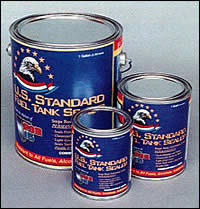|
POR-15 US Standard Fuel Tank Sealers
Q. WHO USES FUEL TANK SEALER?
- People who restore, rebuild, or repair cars,
boats, or other vehicles; companies with fuel storage tanks
-
Non-restoration people who have fuel tanks
or utility tanks in need of repair.
Q. WHAT ARE SOME TYPICAL PROBLEMS REQUIRING
NEED OF SEALER?
Tanks may be very rusty inside due to years
of non-use.
Tanks may have gum, varnish, or caked sludge
deposits inside, which-must -be removed before sealing can be done.
Tanks may have pinhole leaks or leaking seams.
Tanks may have a combination of the above.
Q. CAN TANKS BE TREATED WITHOUT REMOVAL
FROM VEHICLES?
Usually not. Occasionally a tank will have
a small leak on the bottom which can be treated without removal, but that
is the exception. Proper fuel tank sealing almost always requires tank
removal from the vehicle.
Q. YOU CLAIM U.S. STANDARD FUEL TANK
SEALER IS 'THE BEST FUEL TANK SEALER MONEY CAN BUY'. WHY IS IT BETTER THAN
OTHERS?
A. It's better because it seals pinholes
and seams with a non-porous film barrier that won't crack, chip, or peel.
Other sealers are little more than paint or adhesive-type coatings with
little or no intrinsic film strength.
U.S. STANDARD SEALER puts a moisture-proof
barrier between the tank walls and the fuel.
Q. DOES US STANDARD FUEL TANK SEALER
CONTAIN 'RUST INHIBITORS' THAT OTHER SEALERS CLAIM TO HAVE?
A. Any chemical can be called a rust inhibitor,
since practically all coatings will stop rust for a short period of time
until they are eaten away by moisture or wear and tear. Some oils will
inhibit rust for a limited period of time, also. But the only real way
to stop rust permanently is to keep moisture away from metal with a non-porous
coating that is strengthened by exposure to moisture. Only U.S. STANDARD
FUEL TANK SEALER does this, and that's why it's the best product.
Q. HOW MANY TYPES OF FUEL TANK SEALER
ARE THERE?
A. There are two basic types of tank sealer
other than U.S. STANDARD, and they are similar to each other in basic structure:
-
PVC type sealer is similar to the adhesive
used to seal PVC pipe as used in waste disposal lines, sewer lines, etc.
This material is white in color, coats well, but doesn't fill holes or
seams well because it has poor film strength and is essentially an adhesive
rather than a coating. It is highly flammable and has strong ketone vapors
which are dangerous to people with heart conditions.
-
PVC-type non-curing sealer is yellow in color
and will dissolve in gasoline con.tain.ing alcohol and other additives,
which makes it dangerous to use in ANY gas tank. Adheres well but never
dries fully, and it can easily be scratched off with your fingernail. Contains
highly hazardous ketone solvent M.E.K.
Q. WHAT TANK PREPARATION IS REQUIRED BEFORE
USING US STANDARD FUEL TANK SEALER?
A. If tank contains sludge, gums, varnishes,
or rust due to years of neglect or non-use, it should first be cleaned
thoroughly with POR-15 MARINE=CLEAN to remove all foreign matter. Mix 1
quart MARINE=CLEAN with 1 quart hot water, put in tank for 24 hours and
agitate frequently. Repeat process until tank is clean. Next, use POR-15
MET§AL-READY to etch inside surface of tank and to remove all rust.
Next, rinse tank thor.ough§ly with water several times to remove all
remnant chemicals and dry. TANK MUST BE BONE DRY INSIDE BEFORE USING U.S.
STAN.DARD FUEL TANK SEALER. Use a hair dryer or other blower to insure
tank is completely dry before sealing.
Q.MUST I ALWAYS USE A FUEL TANK SEALER
AFTER THOROUGHLY CLEANING OUT MY TANK?
A. No. Fuel tank sealer should be used
as a last resort, and is not always necessary. Fuel tanks that are rust-free
and have no pinholes or leaks may not need sealing at all. They should,
however, always be kept full of fuel, which prevents condensation and further
rusting. If vehicles are not used frequently, fuel tanks should be treated
with POR-15 FUEL PRESERVATIVE/STABILIZER, which will keep fuel fresh for
two years or more and insure quick starts even after months of non-use.
Q. CAN U.S. STANDARD FUEL TANK SEALER
BE RE-USED?
A. No. Used Fuel Tank Sealer should be
discarded because it absorbs moisture from the atmosphere during application
and will not adhere properly a second time.
PHYSICAL
CHARACTERISTICS
| Boiling Point: |
Not Established |
| Vapor Pressure: |
1.4x104mm Hg at 25oC(MDI) |
| Vapor Density(Air=1): |
4.1 |
| Solubility in Water: |
Nil |
| Odor: |
Slightly aromatic |
| Viscosity(Range @ 77oF: |
200-500 CPS |
| Specific Gravity(water=1): |
1.4 |
| % Volatile by volume: |
26% |
| Color: |
Light gray |
| Volatile organics: |
2.23 gr/liter |
| Flash Point: |
104oF |
| Current TLV: |
|
| ACGIH: |
0.02ppm(0.2mg/m3) |
| For Solvent: |
200ppm |
| Ceiling value OSHA (PEL): |
Same |
| Flammable limits LEL: |
1% |
| Flammable limits UEL: |
7.1% |
|



